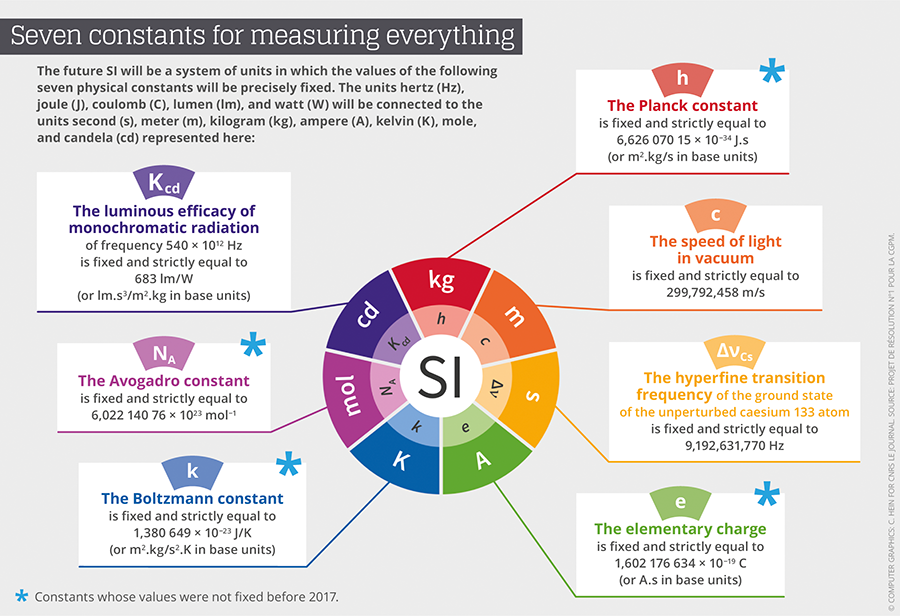
Today, 20 May, is World Metrology Day, an annual celebration of the signature of the Metre Convention on 20 May 1875, the Convention which set the framework for global collaboration in the science of measurement and in its industrial, commercial and societal applications, above all through the International System of Units (SI).
This year’s theme is Metrology in the Digital Era, a topic which provides an occasion to discuss the contribution of CODATA, as the Committee on Data of the International Science Council (ISC), to the science of measurement and our longstanding collaboration with the Bureau International des Poids et Mésures (BIPM), the organisation established by the Metre Convention and which is the home of the International System of Units (SI) and the international reference time scale (UTC). An MoU signed in October 2021, recognises the ongoing partnership between CODATA and BIPM in a number of areas.
The CODATA Task Group on Fundamental Constants has provided recommended values for the fundamental physical constants since 1969. This work builds on data provided by metrology institutions around the world, and for many years the BIPM has hosted the meetings and documentation of the Task Group. Since 20 May (World Metrology Day) 2019, the values of the defining constants for all seven SI base units are derived from the CODATA recommended values of the corresponding fundamental constants.

For quantitative data to be FAIR, we need (at least) to have unambiguous definitions of the measured quantity, and of the units in which the measurement is expressed, and for these definitions to be actionable by both humans and machines. Recognising this, the CODATA Task Group on the Digital Representation of Units of Measurement (DRUM) seeks to engage with scientific communities, in particular through the International Scientific Unions and Associations that are members of the ISC, to increase the understanding and implementation of digital unit representation. To this end, DRUM invited each union or association to nominate an Ambassador to engage with the initiative.
Building on an earlier manifesto, ‘Units of Measurement for Humans and Machines’, the DRUM TG (with colleagues from the CIPM’s Digital SI Task Group) has recently published a comment article in Nature: ‘Stop squandering data: make units of measurement machine-readable’ describes some of the pervasive challenges caused by absent or inconsistent documentation of units. The current activity around FAIR cannot succeed unless the fundamental issue of consistent, machine-readable description of units in data is also addressed.
The article provides an overview of current activities globally, the role of DRUM and the Digital SI Expert Group. It includes a Call for Action ‘to create interoperable data with machine-readable quantities and units of measurement.’*
CODATA and DRUM were major contributors to the BIPM’s online workshop ‘The International System of Units (SI) in FAIR digital data’ held in February 2021. Among other things, this forum explored the need for and the potential characteristics of ‘a “Digital SI” framework’. An outcome of the workshop was a Joint Statement of Intent On the digital transformation in the international scientific and quality infrastructure, agreed by BIPM, ISC, CODATA, the International Organisation of Legal Metrology (OIML), and the International Measurement Confederation (IMEKO). The statement expresses the organisations’ support for the development, implementation, and promotion of the SI Digital Framework as part of a wider digital transformation.
The next step in this collaboration will be the Units Summit @ SciDataCon and BIPM. The DRUM TG and BIPM are convening a series of events to coincide with meetings at BIPM and with SciDataCon 2022 (one of the two conferences comprising International Data Week) 20-23 June.
The ‘Units Summit’ will start with two sessions at SciDataCon:
Colleagues wishing to attend the SciDataCon leg of the ‘Units Summit’ should please register for International Data Week. The sessions will be recorded and accessible from the IDW2022 conference system (but not available publicly for eight weeks after the meeting), so if one of these sessions does not fit your time zone you may ‘attend’ at your convenience by watching the recording in the conference system.
Next, the DRUM TG and BIPM will hold a “Units Summit Recap Meeting” on 21 June at 13:00–15:00 UTC in order to brief colleagues on the SciDataCon sessions and discuss the implications with colleagues from BIPM and the metrology community. Colleagues wishing to attend the “Units Summit Recap Meeting” should please register here.
Finally, on 22 June, 07:00–08:30 UTC, BIPM will host a webinar, Developments Towards Interoperable Metrology, organised by Susan Picard, Janet Miles and Martin Milton of the BIPM. Register here!
How will DRUM and its partners take forward the call to action? There are a number of important activities. Members of DRUM are preparing a machine-readable version of the CODATA Recommended Values for the Fundamental Constants, which is likely to be of widespread utility. DRUM will continue to track and contribute to the SI Digital Framework and the Universal Metrology Data Model. Recommendations for alignment and coordination of units infrastructures will follow.
Above all, the DRUM TG, with partners, aims to build on the call to action in ‘Stop squandering data: make units of measurement machine-readable’ and to continue the engagement with scientific communities, infrastructure developers, data stewards and funders. A second Units Summit is being planned with a focus on implementation: what are the necessary services, functionality, data model, around representation of scientific data in relation to a digital, FAIR SI?
Seven Base Units Table reproduced from https://www.bipm.org/utils/en/pdf/si-revised-brochure/Draft-SI-Brochure-2018.pdf (accessed 31 Oct 2018).
* Hanisch et al., ‘Stop squandering data: make units of measurement machine-readable’, Nature 605, 222-224 (2022): https://doi.org/10.1038/d41586-022-01233-w
Image by Diana Polekhina on Unsplash